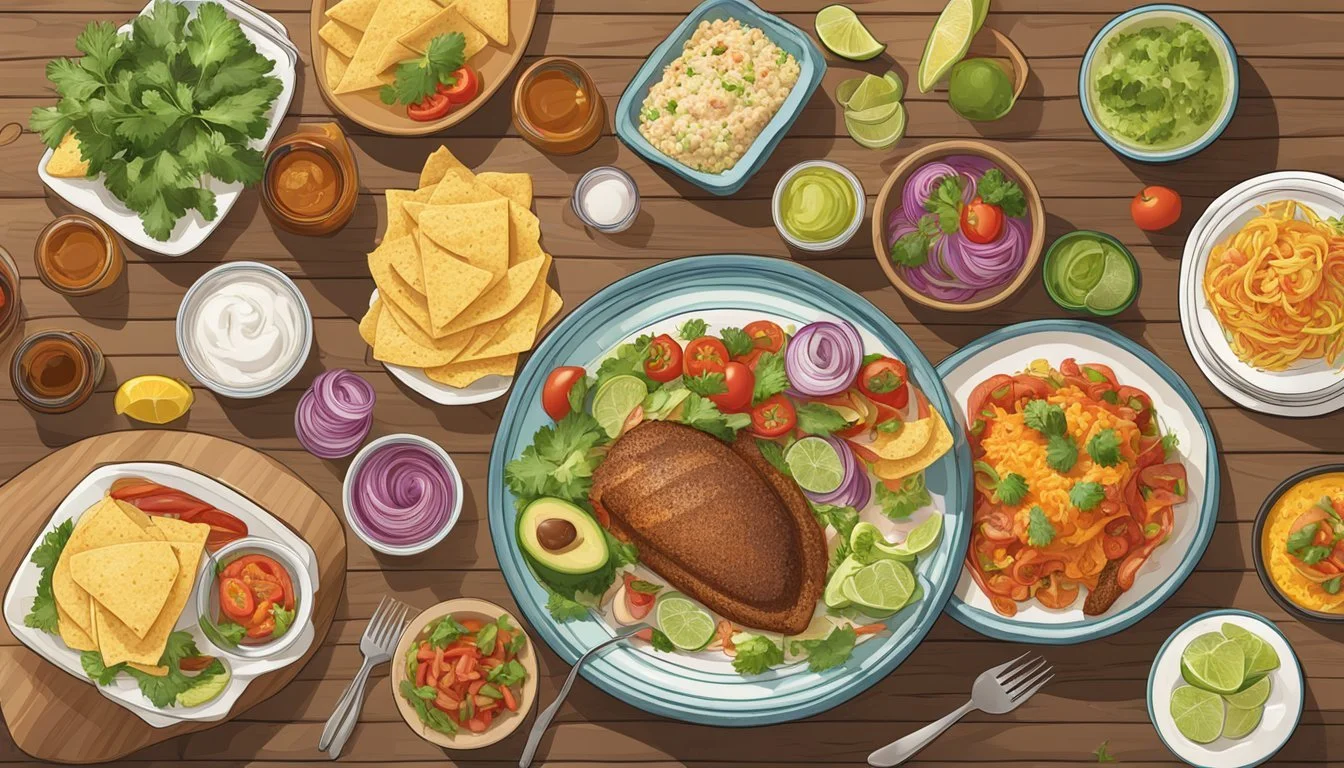German Texan Cookbooks and Culinary Literature
A Fusion of Flavors
German Texan cookbooks and culinary literature offer a vivid window into the fusion of German and Texan culinary traditions. They encompass a rich tapestry of flavors that weave into the broader narrative of Texas's cultural identity. The culinary legacy of German immigrants in Texas stretches back to the mid-1800s, where they instilled a tradition of hearty, robust fare. These settlers brought with them an array of recipes and cooking techniques, vividly captured in cookbooks that amalgamate the German emphasis on precision and the Texan spirit of hearty sustenance.
Through the years, this blend of food cultures has held a prominent place in the pantheon of American regional cuisines. Cookbooks filled with recipes for "hausgemacht" or homemade dishes, alongside tales of early Texan-German communities, testify to the enduring influence of German culinary customs on Texan cooking. These culinary artifacts not only share recipes but also tell stories of cultural unity, adaptation, and evolution.
Observing the cuisine presented in German Texan cookbooks, one notes the prevalence of baked goods, a testament to the German prowess in baking, alongside the traditional meats and stews emblematic of Texan cuisine. The literature is not simply a collection of food recipes; it is a chronicle of the gastronomic journey where old-world flavors have found a new home in the American South. Through this culinary dialogue, the unique cultural exchange between the German settlers and the Texan environment has created a cuisine that is wholly American yet distinctly Texan, bearing the indelible mark of its German heritage.
Historical Context of German Texan Culinary Traditions
In the vast landscape of Texan culinary heritage, German influence plays a defining role, brought forth by 19th-century immigrants. Their impact on regional gastronomy is notable in the rich diversity of flavors found in the Lone Star State.
German Immigration to Texas
German immigrants began settling in Central Texas during the 19th century, driven by the socio-economic upheaval in their homeland. These migrants were instrumental in forming tightly-knit communities which preserved and promoted their cultural heritage, including their culinary practices. Central Texas thus emerged as a core area where German traditions significantly shaped local cuisine.
Key entities:
Migrants: German settlers fleeing socio-economic hardships.
Texas Cuisine: Enriched by German skills in sausage making and baking.
Lone Star State: The cultural melting pot where these culinary traditions took hold.
Culinary Fusion and German Influence
The culinary exchange between German settlers and Texan society introduced transformative methods and recipes. German cooking techniques, particularly in meat processing and pastry-making, left an indelible impact. For instance, the tradition of sausage making, deeply ingrained in German culture, resonated with the existing Southern and Czech gastronomy, leading to the creation of Texas German sausages.
Key entities:
German Culture: Rooted in sausage making and baked goods.
Czech Influence: Parallel to German traditions, contributed to the state's distinctive food profile.
Texas Cuisine: Now features staples like Texas German sausages that reflect this historical fusion.
Key Elements of German Texan Cuisine
German Texan culinary literature offers a unique window into a cuisine that is a robust blend of German traditional methods and Texan flair. The cookbooks and culinary writings reveal a gastronomic narrative that is distinctly flavorful and deeply rooted in both cultures.
Signature Dishes
Chicken-fried steak is an iconic dish in German Texan cuisine. Originating from the European settlers' tradition of frying chicken, this dish was adapted in Texas to use beef, reflecting the state's cattle-raising heritage. It encapsulates the fusion of German and Southern culinary styles, becoming a staple in the region.
Another quintessential element is sausages, specifically Texas German sausages. Historically, German immigrants brought their sausage-making skills to Texas in the 19th century, contributing to the diverse range of sausages found in modern Texan cuisine. These sausages vary from bratwurst to kielbasa, brought to life by seasoning and smoking techniques that enhance their flavor.
Common Ingredients and Spices
Steak: A centerpiece of Texan cuisine, steak is often seasoned with bold spices reflective of both Texan and German palates.
Tacos and tamales: Borrowing from Tex-Mex traditions, these dishes are frequently found with a German twist, such as the incorporation of sausages or sauerkraut.
Regarding spices, black pepper, cumin, and chili powder are staples in German Texan kitchens, used to amplify the flavor of dishes like barbecues (BBQ) and enchiladas. The generous use of spices showcases the hearty and robust character of this regional cuisine.
Cooking Techniques and Styles
This section explores the distinct cooking techniques and styles that define German-Texan culinary literature, with a focus on Texas barbecue and pastry preparation.
Texas Barbecue Methods
In the realm of German-Texan cuisine, Texas barbecue stands out for its unique blend of cultural influences. The method encompasses the fusion of techniques and flavors from German and Czech traditions with local practices. Central to this is the smoking process, which imparts a deep, wood-infused flavor to the meat.
Key components in Texas barbecue:
Smoking: slow-cooking meats over various types of wood such as oak, pecan, or mesquite.
European Influence: incorporation of smoking and curing methods from German and Czech immigrants.
Pastry and Dough Preparation
German-Texan culture celebrates baked goods like bread and kolaches, which showcase expertise in pastry and dough preparation. Recipes for these items often date back generations and are a testament to the blending of culinary traditions.
Techniques for pastries and dough in German-Texan cookery:
Kneading: Developing gluten for texture and structure.
Proofing: Allowing the dough to rise, incorporating air and volume.
Signature pastries include:
Kolaches: Pastries filled with fruits, nuts, or cheese, reflecting the cross-cultural culinary dialogue.
Famous German Texan Cooks and Contributions
The landscape of Texan cuisine is rich with the contributions of German Texan cooks who have expertly blended German culinary traditions with the flavors of the Lone Star State. These cooks have left an indelible mark on the food culture, introducing and perfecting dishes that incorporate the hearty and robust nature of German cooking.
Influential Cooks
Toni Tipton-Martin: As the Editor in Chief of Cook's Country, she has shed light on the German influence in Texan cuisine through her exploration and storytelling.
German settlers in 19th century: Collectively these unnamed cooks brought their expertise in sausage making, baking, and traditional German dishes to Texas.
Culinary Contributions
Sausage Making: Texas German sausages, like those celebrated at Wurstfest, are a testament to the art of German sausage making that has been preserved and adapted in Texas.
Baking: German Texan bakers have imparted their skill, especially noted in pastries and breads that have become staples in Texan diets.
Signature Dishes
Sauerbraten: A marinated pot roast, traditionally served with a thick, hearty sauce.
Schnitzel: Breaded cutlet, which has been adapted into local variations that highlight Texas's love for crispy, fried foods (What wine goes well with fried foods?).
Pastries: A range of European-inspired baked goods that have been woven into the fabric of Texan food culture.
Through the dedicated efforts of these cooks, the commingling of German and Texan flavors continues to be celebrated and enjoyed, not just in Texas but everywhere that has had the pleasure of experiencing this unique and delicious fusion cuisine.
Comparison to Traditional German and Tex-Mex Foods
The rich tapestry of Texan cuisine is marked by the influence of both German and Mexican culinary traditions. This section explores how traditional German flavors compare to Texan adaptations and the unique fusion found in Tex-Mex dishes with German roots.
German versus Texan Flavors
German cuisine (What Wine Pairs Perfectly With German Cuisine) is characterized by its hearty, robust flavors, often centered around meats, sausages, bread, and beer. One finds an array of sausage varieties like Bratwurst and Sauerkraut as staple German dishes. In contrast, traditional Texan foods incorporate the boldness of mesquite-smoked meats and the heat of native chiles, leading to a cuisine that's richer and more intense.
Key German Ingredients:
Sausages (Bratwurst, Knackwurst)
Sauerkraut
Mustard
Potatoes
Bread (e.g., Pumpernickel)
Key Texan Ingredients:
Beef brisket (What wine goes well with beef brisket?)
Chili peppers
Mesquite wood (for smoking)
Corn (as in tortillas)
Beans
Tex-Mex and German Texan Fusion
Tex-Mex cuisine integrates Mexican components such as corn, beans, and an assortment of chili peppers, with the meat-focused cooking methods typical of Texas. The German influence enters the mix principally through the use of meats and sausages, a technique that's well-incorporated into dishes like chili. The result is a melting pot of flavors, where the spiciness of Tex-Mex meets the heartiness of German fare.
Tex-Mex Fusion Examples:
Chili with German sausage added
Tacos filled with smoked sausage
Enchiladas with a side of German potato salad
German Texan cookbooks and culinary literature document these cross-cultural creations, offering insight into a unique subculture of Texan cuisine where one can appreciate a blend of the old-world and Tex-Mex kitchens, producing distinctive flavors that highlight the best of both worlds.
Cultural Significance and Food Festivals
German-Texan culinary traditions reflect a unique fusion of cultures, best showcased during the myriad of food festivals throughout the state.
Annual German Texan Festivals
Wurstfest in New Braunfels stands as a tentpole event in the German-Texan festival calendar. Every November, it attracts over 100,000 guests who immerse themselves in a celebration that spans ten days. The festival's core is its Germanic culinary offerings, perfect for those seeking to experience traditional sausage and beer varieties in a festive atmosphere.
Wurstfest
Location: New Braunfels, Texas
Duration: 10 days in November
Highlight: German sausage and beer
Culinary Events in Texas
San Antonio also plays host to culinary events that epitomize the rich German influence on Texan cuisine. Through these events, varied cultures within Texas come together, sharing and celebrating their historical lineage through food. Culinary exhibitions and historic cafes offer dishes such as sauerbraten and schnitzel, which uniquely blend German cooking techniques with Texan flavors.
Culinary Exhibitions
Occurrence: Various throughout the year
Features: Fusion of German culinary techniques with Texan ingredients
Specialties: Sauerbraten, Schnitzel
Festivals and casual culinary events offer insights into the importance of food heritage in Texas, allowing for a deeper understanding and appreciation of the state's diverse culture.
Influence on Vegetarian and Modern Texas Cuisine
German settlers in Texas have left an indelible mark on local vegetarian cuisine, influencing it with their expert baking traditions and flavor profiles. Vegetarian dishes (What wine goes well with vegetarian dishes?) in modern Texan cookbooks often reflect a blend of these German influences with native Texan ingredients and cooking techniques.
Flavors characteristic of German cuisine, such as caraway, dill, and mustard, have found their way into vegetarian recipes, adding complexity to plant-based dishes. The meticulousness of German pastries manifests in vegetarian baking, where precision in the blend of spices and ingredients ensures delightful tastes without the need for animal products.
In contemporary Texas cookbooks, one might find examples of:
Heartier vegetarian entrées that incorporate German flavors, like a reinvention of the classic sauerkraut, now paired with a variety of roasted Texan vegetables.
Baked goods that include traditional German techniques, offering a wide array of European-inspired vegetarian treats.
A fine balance of vegetarianism and the bold essences of German cuisine is prominent in many modern Texan dishes. This fusion showcases a respect for traditional methods while catering to the evolving dietary choices that emphasize plant-based options.
Texas's culinary evolution is illustrated in modern cookbooks that celebrate both vegetarian fare and the rich German legacy. They are a testament to the state’s adaptability and love for diverse flavors, while also highlighting a growing preference for wholesome, meat-free alternatives in the Texas diet.
Documentation and Literature
The rich tapestry of German Texan culinary traditions is recorded through a variety of cookbooks and literature. These documents provide not only recipes but also a window into the cultural and historical contexts of German communities in Texas.
German Texan Cookbook Publications
"Rezepte: German-Texan Culinary Art, When Everything Was Hausgemacht" stands as a testament to the German influence in Texan cooking, with Nevilee Maass Weaver as a key figure in compiling these culturally significant recipes. Notably, the book signifies the transference of traditional German recipes into the Texan culinary landscape, amalgamating local ingredients into time-honored techniques.
Collections such as "The First Pennsylvania-German Cookbook" also shed light on the evolution of German Texan cuisine. They mirror the adaptation of German culinary heritage as it blended with local influences in Texas, moving away from the High German language to accommodations with the local dialect and tastes.
Library Collections and Copyrights
Libraries play a crucial role in preserving these culinary anthologies. Physical copies of such books can often be found in library special collections, preserving not only the recipes but also the accompanying photographs and historical anecdotes that tell a broader story.
Regarding copyright, most cookbooks published before the 20th century are likely in the public domain, allowing them to be digitized and accessible to the public. However, copyright laws protect more recent publications, necessitating libraries to carefully navigate copyright agreements, especially when it comes to sharing the material online or reproducing it.
Conclusion
German Texan cookbooks and culinary literature serve as important historical documents, reflecting the fusion of German and Texan food cultures. These cookbooks provide insights into the dietary practices and social customs of German Texans, showcasing recipes that combine traditional German techniques with local Texan ingredients.
Key contributions:
Documentation of culinary evolution within the German Texan community.
Preservation of traditional German recipes adapted to the Texan environment and ingredient availability.
A window into the domestic lives of German Texans and their efforts to maintain cultural identity through food.
German Texan culinary literature illustrates how food acts as a means of cultural expression and adaptation. It tells a story of immigrants retaining their heritage while embracing the influences of their new homeland. This literature is not simply a set of recipes; it's the narrative of a people carving out a unique identity through cuisine.
Researchers and enthusiasts alike should value these works for their role in capturing the essence of cultural adaptation. They are resources for both historical study and contemporary culinary exploration, offering a rich palate of heritage and innovation on the plate.










